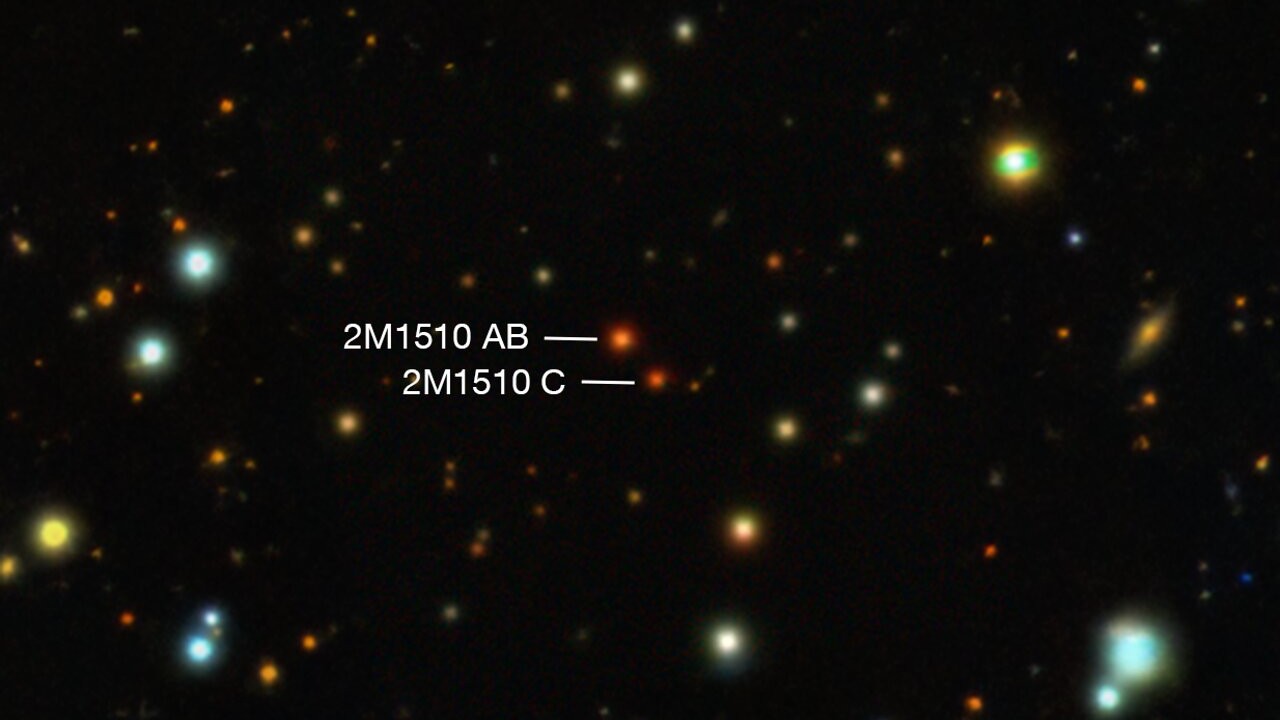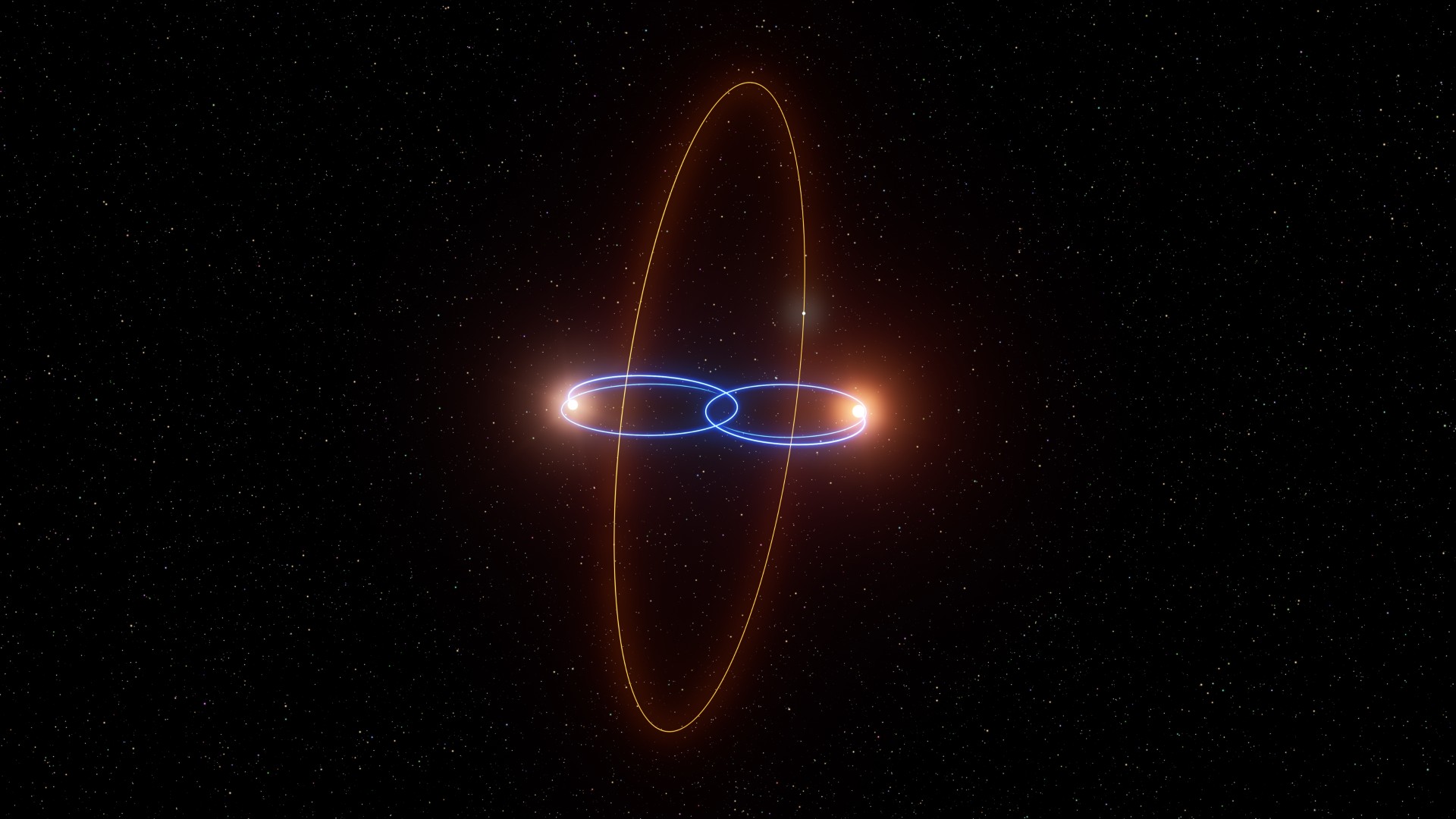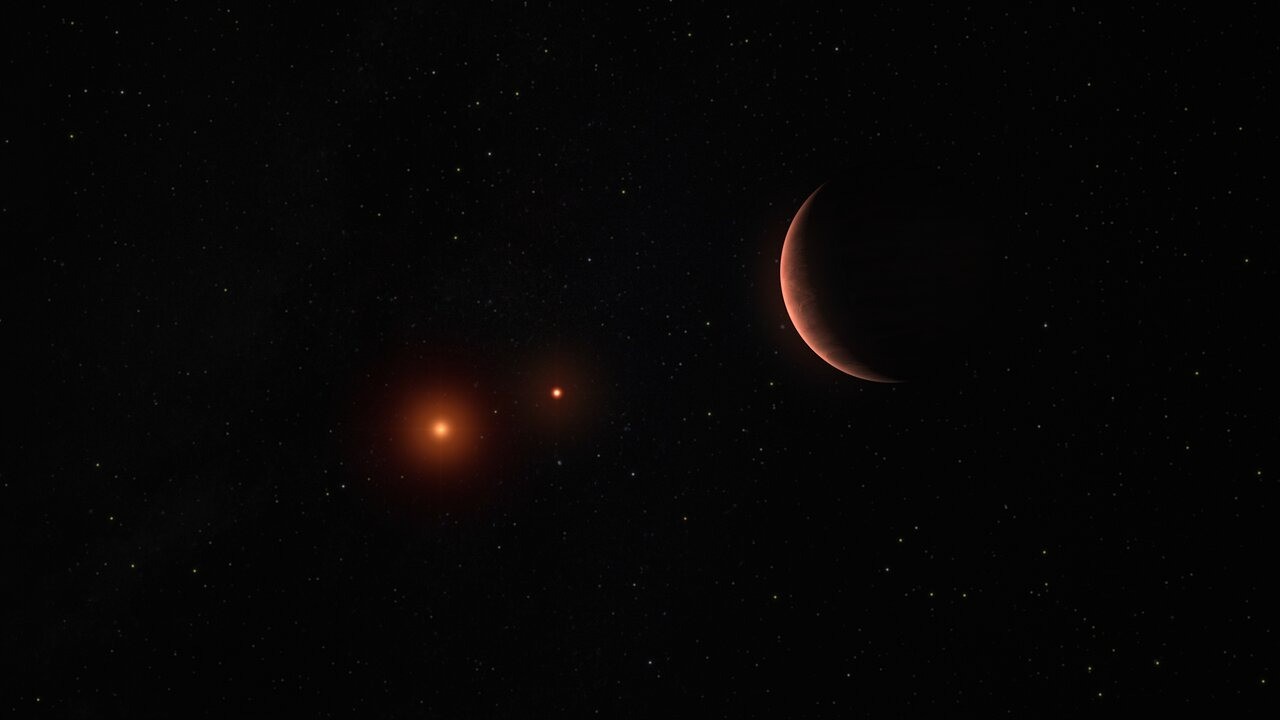A Tatooine-like world with a key difference from the desert planet in "Star Wars" has been serendipitously discovered orbiting not two stars, but a pair of brown dwarfs. What's more, this wacky planet doesn't orbit around the brown dwarfs' equator, but instead up and down over their poles.
In the "Star Wars" universe, Luke Skywalker famously came from the planet of Tatooine, which had two suns and double sunsets. Tatooine is in a circumbinary orbit, which means that it doesn't orbit one star, but instead orbits both stars of a binary system.
Binary systems are common in our Milky Way galaxy — about two-thirds of all stars (and brown dwarfs) are found in binary systems. Yet given the near ubiquity of these stellar pairs, very few planets have been discovered on circumbinary orbits — just 16 up until now.
Those 16 all orbit around the equatorial plane of their double star system — such orbits are said to be 'co-planar'. This is just one of the reasons that this new Tatooine-like planet, which is 118 light years away and called 2M1510(AB)b, is rather unique.
Another reason is that it orbits two brown dwarfs (which also happen to eclipse each other from our point of view, and are only the second pair of eclipsing brown dwarfs to have been found). Brown dwarfs are sometimes referred to as 'failed stars' — they are objects that form like a star by collapsing directly out of a molecular gas cloud, but which are not massive enough to generate the temperatures and pressures required at their core for hydrogen-based fusion reactions.
The concept of planets on polar orbits isn't entirely surprising. Previous studies have discovered planets on polar orbits around single stars, while the Atacama Large Millimeter/submillimeter Array (ALMA) in Chile has observed dusty protoplanetary disks tilted around young binary stars. However, 2M1510(AB)b is the first bonafide planet to be found on a circumbinary polar orbit.
"Our expectation is that the planet would have formed in an inclined disc, such as those observed by ALMA," said Amaury Triaud, a professor of astronomy at the University of Birmingham, UK, in an interview with Space.com. Triaud was part of the research team that discovered this planet.
There are, however, some caveats. One is the planet's distance from the brown dwarfs, which at this current time is unknown. If it is too far away, then the disk from which it formed would have been harder to tilt. In this case, alternative ideas would have to be considered, such as an interaction with a passing star.
We don't know the orbital period of 2M1510(AB)b, nor its diameter and mass, because this planet wasn't discovered in a conventional way. Triaud is part of a team led by Thomas Baycroft, who is a PhD student at Birmingham. They were targeting the brown dwarfs with the Very Large Telescope in Chile, with the aim of constraining the two brown dwarf's orbital parameters around each other.

But they began to notice the very subtle effect of the brown dwarfs being tugged this way and that by an unseen body. Putting their data into various models, they found that the best explanation is that of a large planet, between 10 and 100 times the mass of Earth, on a polar orbit aligned 90 degrees to the equatorial plane of the brown dwarfs.
Intriguingly, a circumbinary polar orbit is more stable than a co-planar orbit, says Triaud. This is not necessarily the case for planets on polar orbits around single stars.
"We still do not fully understand why certain planets orbiting single stars are on polar orbits, and since what we've found is the first polar circumbinary geometry, we also do not know much about it," he said. "For single stars, the planetary orbit could have misaligned, or the stellar rotation axis could have moved. A final scenario, which I am very skeptical about, is that polar planets orbiting single stars were once circumbinary planets themselves, with the two stars coalescing."
Audiences have been wowed over the years by Tatooine's double sunset in Star Wars, and planets in circumbinary orbits do have different diurnal and seasonal patterns compared to Earth. On a circumbinary planet, the length of day would depend upon how far apart the stars are in the sky at any one time. At their widest angular separation, the days would last longer than when the stars are close together in the sky.

Also think about their orbits. The two stars are orbiting the center of mass between them, and a circumbinary planet orbits both stars as they move about this center of mass. As the planet orbits around them, it will at different times find itself closer to one star than the other, and at other times be equidistant to both stars. This dance of stars and planet would undoubtedly have an effect on the planet's climate.
"A circumbinary planet experiences a sort of seasonal modulation, on roughly the timescale of the binary orbit, or half of it," said Triaud.
There's lots of potential permutations here. If both stars are of similar mass, then the planet will experience winter when it is closer to just one of them, and summer when they are equidistant. If they have different masses, say a sun-like star and a cool, feeble red dwarf, then the warmer seasons would occur when a circumbinary planet is closer to the more massive star. It's even plausible that a planet could dip in and out of the habitable zone — it would be inside the habitable zone when it's closer to the more massive star, and out when it is nearer the smaller, cooler star.
But how would a circumbinary planet on a polar orbit fare?
"A polar planet would also feel a little like this since the stars constantly move and change distance relative to the planet, but the effect would be reduced compared to a co-planar situation," said Triaud.
The 2M1510 system also has a third brown dwarf farther out that the planet does not orbit. It is unlikely that there would be life on 2M1510(AB)b — brown dwarfs are far too cool to keep a planet warm enough for liquid water.
Luke Skywalker's homeworld of Tatooine is a dry desert world, with very subtle seasons. During the double sunset, we see two sun-like stars close together. Perhaps they are on a tight orbit around one another, meaning their distance from the planet stays fairly similar. Luke found life on Tatooine to be boring, but he should be glad, because as we have seen, binary stars have the potential to play all kinds of havoc on their orbiting circumbinary planets.
The discovery of this first-ever circumbinary polar planet was published on April 16 in Science Advances.
.png)
 German (DE)
German (DE)  English (US)
English (US)  Spanish (ES)
Spanish (ES)  French (FR)
French (FR)  Hindi (IN)
Hindi (IN)  Italian (IT)
Italian (IT)  Russian (RU)
Russian (RU) 









Comments